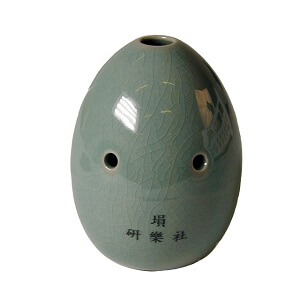Hun
 The "hun" is a Korean ocarina made of baked clay or ceramic. It is globular shape, with a blowing hole on top and several finger holes. It is used primarily in court music ensembles, although in the late 20th century some contemporary Korean composers began to use it in their compositions and film scores.
The "hun" is a Korean ocarina made of baked clay or ceramic. It is globular shape, with a blowing hole on top and several finger holes. It is used primarily in court music ensembles, although in the late 20th century some contemporary Korean composers began to use it in their compositions and film scores.
The "hun" is derived from the Chinese "xun", one of the oldest Chinese instruments. In Japan, the equivalent instrument is called "tsuchibue" (lit. "Japanese clay flute").
The hun may look more like a vase than a musical instrument, but it is actually a more rotund relative of the ocarina. Made of baked clay, it has a blowing hole at the top and five finger holes around its diameter; it is held in two hands, as the fingers are closed and opened to make the notes. It was primarily used in temples in the 12th century, but more recently had a resurgence when some Korean composers began to use it in film scores.